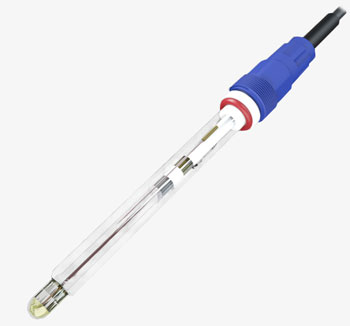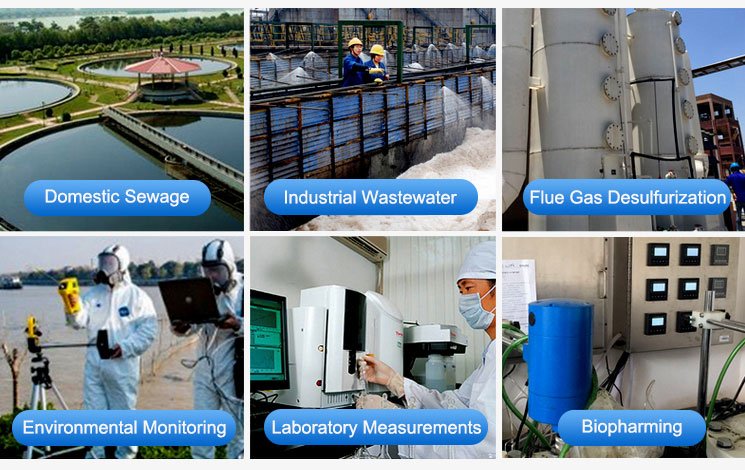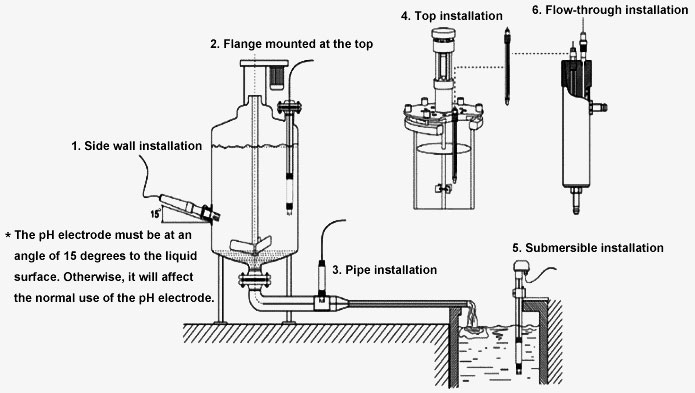High-temperature pH glass electrodes with two glass laminates, high temperature and high-pressure resistance, applicable to mining and smelting, paper, pulp, textiles, petrochemical, and semiconductor electronics industries.

Resistant to strong acid and alkali corrosion, online pH measurement
- Adopt a sensitive glass bulb with an area of 217.6 square millimeters, and five layers of glass-film.
- The shell material is special glass, high temperature resistant, high-pressure resistant, and an increase of 30% impact resistance strength.
- External reference electrode increases Ag+, prevents salt bridge blockage, ensures accurate output signal, and has a longer service life.
- Accessories: PTFE sheath or stainless steel sheath. Increase the acid and alkali resistance of the electrode, easy to install.
- The high-quality low-noise cable can achieve 60m long-distance signal transmission.
Application
pH Electrode is widely used in the continuous testing and monitoring of pH, ORP, and temperature in thermal power, chemical fertilizer, metallurgy, environmental protection, pharmaceutical, biochemical, food, drinking water, etc.

| Model | SISCO-PH5018 | SISCO-PH5015 |
| Measuring Range | 0-14 pH | |
| Temperature Range | 0-100℃ | 0-130℃ |
| Pressure Resistance | 0.25 MPa | 0.6 MPa |
| Salt Bridge | Porous ceramic core/porous TEFLON | Single Point Ceramic Salt Bridge |
| Temperature Compensation * | NTC10K, PT100, PT1000 | |
| Shell Material | Glass | |
| Response Time | 1min | |
| Cable Length * | 5m/10m/15m, or other length less than 50m (need customization) | |
| Service Life | 6 Months | |
| Weight | 1 kg | |
Specification of sheaths (optional accessories)
| Model | SISCO-PHETE-A1 | SISCO-PHETE-A2 |
| Internal thread | PG13.5 pipe thread | PG13.5 pipe thread |
| External thread | 3/4NPT | 3/4NPT |
| Material | PTFE (Polytetrafluoroethylene) | Stainless steel |
Installation

- Side wall installation (*The pH electrode must be at an angle of 15 degrees to the liquid surface. Otherwise, it will affect the normal use of the pH electrode.)
- The flange mounted at the top
- Pipe installation
- Top installation
- Submersible installation
- Flow-through installation
Q1: What is a pH electrode?
A1: The pH electrode is also called the pH probe pH sensor. The pH electrode is the part of the pH meter that is in contact with the substance to be measured and is used to measure the electrode potential.
Q2: Why do pH electrodes need to be soaked?
A2: The pH electrode must be soaked before use, because the pH bulb is a special glass membrane with a thin hydrated gel layer on the surface of the glass
membrane, which can only interact with the H+ ions in the solution under fully wet conditions. the response to. At the same time, after soaking the glass
electrode, the asymmetric potential can be greatly reduced and tend to be stable.
Q3: What is a reference electrode?
A3: An electrode with a known and constant electrode potential that does not respond to the activity of hydrogen ions in solution is called the reference electrode. Reference electrodes include mercurous sulfate electrodes, calomel electrodes, and silver/silver chloride electrodes. The most commonly used are calomel electrodes and silver/silver chloride electrodes. The role of the reference electrode in the measurement cell is to provide and maintain a fixed reference potential, so the requirements for the reference electrode are that the potential is stable and reproducible, the temperature coefficient is small, and the polarization potential is small when current flows.
Tips: What is a pH-indicating electrode?
An electrode that responds to the activity of hydrogen ions in a solution and the electrode potential changes accordingly is called a pH-indicating electrode or pH-measuring electrode. pH-indicating electrodes are available as hydrogen electrodes, antimony electrodes, and glass electrodes, but the most commonly used electrode is glass. Glass electrodes are made up of glass stubs and a hydrogen ion-sensitive glass membrane made up of special ingredients. The glass membrane is generally in the shape of a bulb, which is filled with an internal reference solution, inserted into the internal reference electrode (usually silver/silver chloride electrode), sealed with an electrode cap to connect the lead wire, and fitted with a socket, then it becomes a pH indicator electrode.
Thank you for buying industrial test and measurement equipment on SISCO.com, all products sold by SISCO and the partner cover a 12 months warranty, effective from the date of receiving the products.
What is covered?
SISCO is responsible for providing free spare parts, and free technical support to assist the customer to repair the defective products until the problem is solved.
What is not covered?
- Product purchased from anyone other than a SISCO store or a SISCO authorized reseller.
- Expendable parts.
- Routine cleaning or normal cosmetic and mechanical wear.
- Damage from misuse, abuse or neglect.
- Damage from use of parts other than SISCO approved.
- Damage from use outside the product’s usage or storage parameters.
- Damage from use of parts not sold by SISCO.
- Damage from modification or incorporation into other products.
- Damage from repair or replacement of warranted parts by a service provider other than a SISCO authorized service provider.
- Damage caused by the application environment not meeting the product usage requirements and the failure to perform preventive maintenance.

